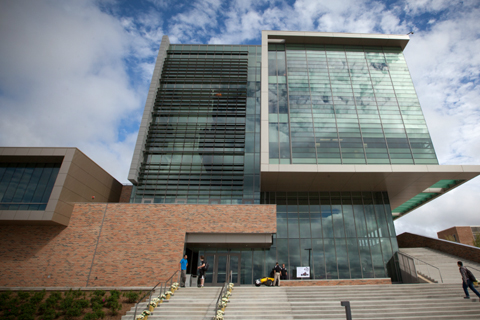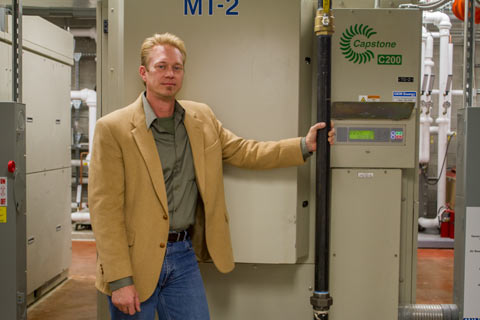
 |
| The latest “green” addition to Oakland University’s campus is the Engineering Center. Chilled beams cool the building, two 200kW Combined Heat Power (CHP) microturbines provide a large portion of electricity and waste heat is brought back into the building for space and heating. Pictured is James Leidel, director of Clean Energy Systems, in the penthouse mechanical room on the 6th floor of the Engineering Center. |
With eco-friendly courses and clean energy efforts across campus, it’s no surprise that Oakland University has a good reputation for “going green.” Infrastructure and courses help build morale towards energy efficiency, from the power supplied to the campus to the School of Engineering and Computer Science itself.
“Energy-efficient buildings have made a huge difference to the entire university,” said Louay Chamra, dean of Engineering and Computer Science. “These clean energy systems provide a healthy indoor environment for the students, faculty and staff. Furthermore, we are being a great neighbor to our surrounding communities by caring about the environment and implementing many energy conservation techniques to qualify for top LEED honors.”
Efficient facilities
From the Human Health Building (HHB) to the Clean Energy Research Center (CERC) and the new Engineering Center, OU is filled with an abundance of energy-efficient and environmentally-friendly establishments.
OU’s campus will utilize multiple existing and planned sources of on-site clean energy, according to James Leidel, director of Clean Energy Systems. A Central Heating Plant gas turbine, SECS microturbines, solar projects and a dual-fuel diesel-gas peaking system, among others, are the separate entities of clean energy at the school.
“It saves money, and being energy-efficient is the right thing to do,” Leidel said. “These buildings are examples of green technology and clean energy. What better place than a university to engage in this sort of technology? Universities should be at the forefront to demonstrate and to educate.”
Human Health Building
The HHB was completed in fall 2012, and is the only campus building certified Leadership in Energy and Environmental Design (LEED) Platinum designation in Michigan, assisted by Leidel’s $2.75 million geothermal technologies grant from the U.S. Department of Energy.
The building features energy-efficient LED lighting, a geothermal heating and cooling system, recycled materials, a 50kW solar PV system on the penthouse and a large solar thermal system to assist the geothermal cooling with summer desiccant dehumidification.
Engineering Center
While it hasn’t yet been designated LEED, the Engineering Center is very energy-efficient and would rank Gold, according to Chris Kobus, Associate Professor of Mechanical Engineering, Director of Outreach and Recruitment.
Chilled beams cool the building, two 200kW Combined Heat Power (CHP) microturbines provide a large portion of electricity and waste heat is brought back into the building for space and water heating.
Clean Energy Research Center
Another innovative clean energy building on campus is the CERC, which uses LED and induction lighting and is heated by a high-tech, automated wood chip boiler.
The CERC was made possible with a $500,000 grant from the U.S. Department of Energy. Chamra said that the goal is to make the entire campus “the first sustainable campus in the US.”
The CERC is embedded in the OU INC, a Smartzone business incubator located on the OU east campus’ Shotwell Pavilion.
U.S. Department of Energy grants helped fund the CERC bio-energy demonstration modules and building wood chip boiler, the geothermal/solar-thermal system for HHB, solar PV projects and an outdoor LED lighting pilot project with DTE Energy.
“Heating the entire campus on wood chips would make an even more significant impact,” Kobus said.
The study and proposal undertaken by Leidel, formerly with Facilities Management, culminated with a public bid and a third-party financed proposal. However, as natural gas prices fell, the project was shelved in favor of a Central Plant CHP gas turbine.
In October 2013, the OU Board of Trustees approved Chevron Energy Solutions to undertake a public-private partnership for a 4.6MW natural gas CHP system.
The Chevron group recently spun out to a new company, OpTerra Energy Services, and installed and operates the CHP system to help power and heat the campus. Switching from mostly grid coal to clean-burning natural gas with waste heat recovery will lower OU’s environmental footprint by 40 to 50 percent.
From 2006 through 2008, wind speed data was collected on a 50-meter-tall meteorological tower and a wind power study was commissioned by Leidel.
Resources for learning
In addition to being an eco-friendly energy producer on campus, the CERC provides engineering students and faculty with a place for research projects and hands-on opportunities with operated bio-fuel production systems.
“Clean or renewable energy is important because of the great environmental and economic benefits,” Chamra said. “In addition, the clean energy systems will be used as living laboratories for SECS students and faculty to study and conduct research.”
While there is a limited budget, there are still many volunteer and internship opportunities — paid and unpaid — to help students gain class credit and real-world experience.
Students can come to Kobus or Leidel to help on existing projects, or pitch proposals of their own.
“I definitely want more people here helping,” Leidel said. “Students get to see hands-on real equipment — it’s not just lab-scale. We have real equipment operating and they’d work with hardware and prototyping. I focus on real-world experiences in the university environment.”
|
“All the buildings built on campus, including HHB, the new residence hall and the new Engineering Center, are being designed as living laboratories.”
— Chris Kobus, Associate Professor of Mechanical Engineering, Director of Outreach and Recruitment
|
In addition to research, the building and structure of the campus can be a clean energy living laboratory.
Through outreach programs, younger students get a taste of engineering and computer science, during week-long summer STEM camps.
Students tour campus, where they learn how the grid works and are shown the modern architecture and green design and technology of the buildings.
“As part of the outreach program and the one-week camps we brought here in the summer, there are always tours going on there and it’s not a campus tour like admissions does, it’s more of a technology tour,” Kobus said. “We’ve gotten great feedback on the tours. The kids love seeing technology in action — they’ve seen some really neat stuff.”
According to Kobus, the buildings also provide great research experience for University students to learn outside the classroom without going too far away.
His students learn from the school’s energy system and efficient buildings; and many professors take their students to CERC for research and field trips.
“All the buildings built on campus, including HHB, the new residence hall and the new Engineering Center, are being designed as living laboratories,” Kobus said. “We can teach students theory in the classroom with little table-top experiments to get practical experience, but to go out and see it in its full form — that’s really what we want. So when we design these buildings, we design them with the perspective that we want this to be part of a learning laboratory for students to be able to tour through and see the technology in action.”
Education in energy
With the resources available, it’s also important to understand how everything works. More energy-focused courses are being made available for students.
Recently, classes in energy efficiency have been proposed and added, and now engineering students can take their studies a step further with the new energy management master’s concentration. Kobus described it as a course teaching how “to optimize energy distribution systems, better manage environmental resources and help employers or clients significantly reduce energy costs.”
The class “Alternative Energy Systems” goes over major energy technologies. There is also a hybrid electric battery course and a fuel cell class, in addition to a series of three other conservation-focused energy management courses that will be taught executive-style next summer.
“The one technology that is truly clean is the energy you never use, so if you can learn to do more with less, not using energy is the cleanest thing you can do — conservation is number one,” Kobus said. “In the alternative energy universe, if you don’t have conservation first, simply switching to other sources makes little sense.”
Leidel is looking to launch more classes in clean energy to drive the importance back home and give students more experience learning about power systems engineering and combined heat and power systems.
“We have a lot of infrastructure projects,” Leidel said. “The existence of the Clean Energy Research Center, combined with multiple infrastructure projects provides a comprehensive educational front in clean energy systems. Students are drawn to Oakland by the visibility of these systems, classes and web sites.
Many students have stated that they come to OU because of the things we’re trying to do with solar power, and the platinum LEED building we have on campus. Clean energy is a significant area of focus for many universities, so to have that here is hopefully a draw for students.”
Right now he is developing a proposal for a clean energy and power engineering program, which could be offered as a master’s program in Clean Energy Engineering.
“The United States is a little behind in clean energy investment,” Leidel said. “However, in Michigan, we have a huge amount of engineering and innovative capacity that can be channeled into the clean energy sector. Here at Oakland, numerous clean energy projects have created a living, learning laboratory for students to experience these systems first hand, and learn. =As additional engineering courses are brought online, they can capitalize on this unique infrastructure.”


